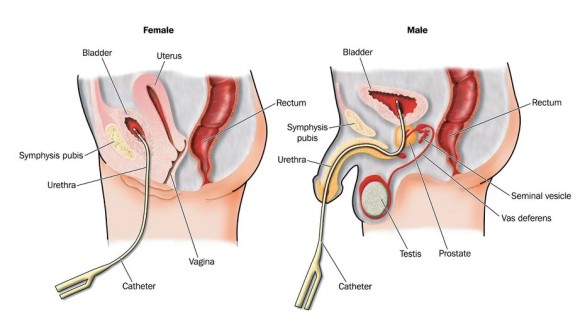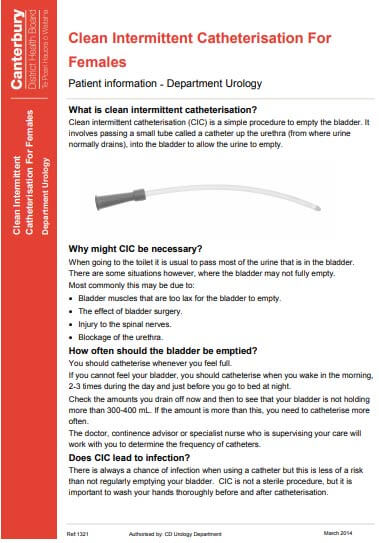Wishing everyone happy holidays and a joyful New Year from the Healthify team. Don't forget to Slip, Slop, Slap and Wrap!
Urinary catheters
Key points about urinary catheters
- A urinary catheter is a thin tube that's used to empty your bladder if you can’t pass urine (wee, mimi) naturally.
- A catheter is inserted into your urethra and through to your bladder to let urine flow from your bladder into a drainage bag or the toilet.
- Catheters can be used either for a short period of time (eg, after some surgeries or to perform certain medical tests) or long-term due to conditions such as urinary retention (can’t wee) urinary incontinence (unable to control when you wee) or paralysis.
- There are different types of catheter, depending on why you need to use one. Some catheters can also go through your abdomen instead.


Image credit: 123rf
Different catheters are used depending on whether they stay in your bladder or are removed once your bladder is empty.
Intermittent catheter
An intermittent catheter is inserted into your bladder to drain the urine, and once your bladder is empty it’s removed.
Intermittent catheters are inserted a few times throughout the day, as decided by your doctor or nurse. Many people learn how to insert a catheter themselves (self-catheterise).
Indwelling catheters
An indwelling catheter (IDC) is a flexible tube inserted into your bladder but, unlike an intermittent catheter, it’s not removed when your bladder is empty. It’s held in place by a small, water-filled balloon that’s connected to the catheter. The catheter is attached to a drainage bag outside your body that can be secured to your leg or rest on the floor.
Some indwelling catheters continuously drain urine from your bladder while others have a valve that is opened every few hours to drain your bladder when it feels full.
Suprapubic catheters
A suprapubic catheter is a tube that is inserted through your abdominal wall into your bladder. Urine is drained from your bladder into a drainage bag outside your body. A small stitch in your abdomen helps to keep a suprapubic catheter in place.
Suprapubic catheters are used when your urethra is damaged or a catheter is unable to be inserted through your urethra. They can be a good long-term option and are more practical for people who are sexually active.
Uridomes or condoms
A uridome is a sheath placed over the penis to collect urine. It's made of silicon and is attached to a urinary bag. These are a non-invasive alternative to a catheter for males with incontinence. They can be helpful to reduce infection. They're not suitable for everyone and require assessment first with an ultrasound of your kidneys and bladder.
The most common complication of catheter use is a urinary tract infection. See your doctor healthcare provider if you have any of the following symptoms:
- Pain or burning during or immediately after passing urine
- Fever, tiredness or shakiness.
- An urge to urinate (go to the toilet) more often.
- Passing small amounts of urine more frequently.
- Pressure in your lower belly.
- Urine that smells bad or looks cloudy or reddish.
Kidney infections, called pyelonephritis, are less common but are still a risk, and can be caused by an untreated or undiagnosed urinary tract infection.
Other complications include:
- bladder spasms
- leakage from the catheter
- no urine draining from the catheter
- blood in the urine or around the catheter.
Your healthcare provider can give you advice and problem-solving tips if you need to use a catheter.
If you’re using a catheter long-term, your healthcare provider will show you how to look after it, including what to do if you have a problem, and tips for managing day-to-day. They will also give you information on how to clean your drainage bags and how to order equipment and supplies.
Although urinary tract infections are common with catheter use, there are ways to minimise your risk:
- Always wash your hands before and after touching your catheter and drainage bag or before any catheter care.
- Most intermittent catheters are single-use only, meaning you throw the catheter away once you’ve used it to drain your bladder. Your healthcare provider will advise you about what equipment you can wash and reuse.
- Wash the area around your catheter every day – women should make sure they wash from front-to-back (eg, wash from your urethra towards your back passage).
- Follow the advice from your healthcare provider.
Looking after your indwelling catheter
- If you have an indwelling catheter, it’s important to make sure your drainage bag is kept lower than your bladder, and make sure there are no kinks in the tubing. This makes sure urine flows from your bladder into the drainage bag and not back up your urethra into your bladder. It’s a good idea to empty your drainage bag regularly during the day so the weight of a full bag doesn’t pull on the tube.
- Most people will be supplied with a bag to use during the day and a different one at night. Catheter bags can be cleaned each day and reused. Your healthcare provider will let you know how often you need to use a new bag (often once a week) and will show you how to properly clean and dry the bags. It’s important to follow their advice to minimise your risk of infection.
- Indwelling catheters are usually changed every 6 to 12 weeks by your healthcare provider.
It’s possible to maintain your sex life with an indwelling catheter – talk with your healthcare provider about ways to manage this.
Apps reviewed by Healthify
You may find it useful to look at some Self-management and healthy living apps.
Your local district nursing service provides ongoing support and management of your catheter cares, including catheter supplies. Talk to your healthcare provider if you need help accessing services.
Urinary catheterisation(external link) Better Health, Australia
You and your catheter [PDF, 303 KB] Counties Manukau DHB, NZ
Managing your uridome at home(external link) Capital & Coast DHB, NZ
Clean intermittent catheterisation for females(external link) Canterbury DHB, NZ
Apps
Self-management and healthy living apps
References
- Urinary catheters(external link) NHS Choices, UK
- Urinary catheters(external link) Health New Zealand | Te Whatu Ora
- Urinary tract infection in men, women, pregnant, and children Healthify He Puna Waiora, NZ
- Urethral catheterisation(external link) Auckland Regional HealthPathways, NZ, 2019
Urinary catheterisation and catheter care(external link) Canterbury DHB, NZ, 2013
Catheterisation clinical guidelines(external link) Australia and new Zealand Urological Nurses Society, 2013
Apps
Brochures

Counties Manukau DHB, NZ, 2014

Canterbury DHB, NZ, 2014
Credits: Healthify editorial team. Healthify is brought to you by Health Navigator Charitable Trust.
Reviewed by: Dr Phoebe Hunt, Medical Officer, Northland
Last reviewed:





